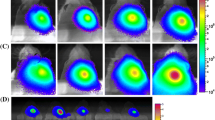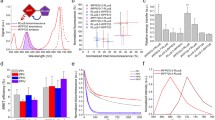Abstract
Purpose
Bioluminescence imaging (BLI) is a technique with a low background noise and high sensitivity which is widely used in mice models in oncology. We aimed to assess BLI efficiency of the new luciferase NanoLuc (Nluc) for glioblastoma cell lines and tumors, including for dual reporter applications of deep brain tumors and systemic metastasis when combined with firefly luciferase (Fluc).
Procedures
U87 cells were genetically modified for constitutive production of either Nluc, Fluc, or both and assayed for luciferase activity and BLI on cell lysates, living cells, subcutaneous tumors, brain tumors, and systemic metastases.
Results
In vitro, light production by Nluc activity is higher than Fluc. In vivo, Nluc allows for tumor detection including for deep brain tumors and systemic metastases.
Conclusions
Nluc appears to be a useful tool to combine with Fluc for dual imaging in vivo using bioluminescence, allowing for the detection of distinct events in deep tissues within the same organism.





Similar content being viewed by others
References
Greer LF, Szalay AA (2002) Imaging of light emission from the expression of luciferases in living cells and organisms: a review. Luminescence 17:43–74
Close DM, Xu T, Sayler GS, Ripp S (2011) In vivo bioluminescent imaging (BLI): noninvasive visualization and interrogation of biological processes in living animals. Sensors 11:180–206
Badr CE, Tannous BA (2011) Bioluminescence imaging: progress and applications. Trends Biotechnol 29:624–633
Contag PR, Olomu IN, Stevenson DK, Contag CH (1998) Bioluminescent indicators in living mammals. Nat Med 4:245–247
Weissleder R, Ntziachristos V (2003) Shedding light onto live molecular targets. Nat Med 9:123–128
Fortin P-Y, Genevois C, Koenig A et al (2012) Detection of brain tumors using fluorescence diffuse optical tomography and nanoparticles as contrast agents. J Biomed Opt 17:126004
Bhaumik S, Gambhir SS (2002) Optical imaging of Renilla luciferase reporter gene expression in living mice. Proc Natl Acad Sci 99:377–382
Tannous BA (2009) Gaussia luciferase reporter assay for monitoring biological processes in culture and in vivo. Nat Protoc 4:582–591
Adams ST, Miller SC (2014) Beyond D-luciferin: expanding the scope of bioluminescence imaging in vivo. Curr Opin Chem Biol 21:112–120
Branchini BR, Southworth TL, Khattak NF et al (2005) Red- and green-emitting firefly luciferase mutants for bioluminescent reporter applications. Anal Biochem 345:140–148
Loening AM, Dragulescu-Andrasi A, Gambhir SS (2010) A red-shifted Renilla luciferase for transient reporter-gene expression. Nat Methods 7:5–6
Otto-Duessel M, Khankaldyyan V, Gonzalez-Gomez I et al (2006) In vivo testing of Renilla luciferase substrate analogs in an orthotopic murine model of human glioblastoma. Mol Imaging 5:57–64
Evans MS, Chaurette JP, Adams ST Jr et al (2014) A synthetic luciferin improves bioluminescence imaging in live mice. Nat Methods 11:393–395
Hall MP, Unch J, Binkowski BF et al (2012) Engineered luciferase reporter from a deep sea shrimp utilizing a novel imidazopyrazinone substrate. ACS Chem Biol 7:1848–1857
He S-X, Song G, Shi J-P et al (2014) Nanoluciferase as a novel quantitative protein fusion tag: application for overexpression and bioluminescent receptor-binding assays of human leukemia inhibitory factor. Biochimie 106:140–148
Stacer AC, Nyati S, Moudgil P et al (2013) NanoLuc reporter for dual luciferase imaging in living animals. Mol Imaging 12:1–13
Acknowledgments
The authors thank Patrick Salaun from Promega-France for the gift of plasmid and furimazine, Dr. Benoit Rousseau, Dr. Pierre Costet, and Laetitia Medan for rearing and taking care of mice.
Funding
This study was supported by Labex TRAIL (ANR-10-LABX-57) and Conseil regional Aquitaine.
Conflict of Interest
The authors have declared no conflicts of interest.
Author information
Authors and Affiliations
Corresponding author
Rights and permissions
About this article
Cite this article
Germain-Genevois, C., Garandeau, O. & Couillaud, F. Detection of Brain Tumors and Systemic Metastases Using NanoLuc and Fluc for Dual Reporter Imaging. Mol Imaging Biol 18, 62–69 (2016). https://doi.org/10.1007/s11307-015-0864-2
Published:
Issue Date:
DOI: https://doi.org/10.1007/s11307-015-0864-2




